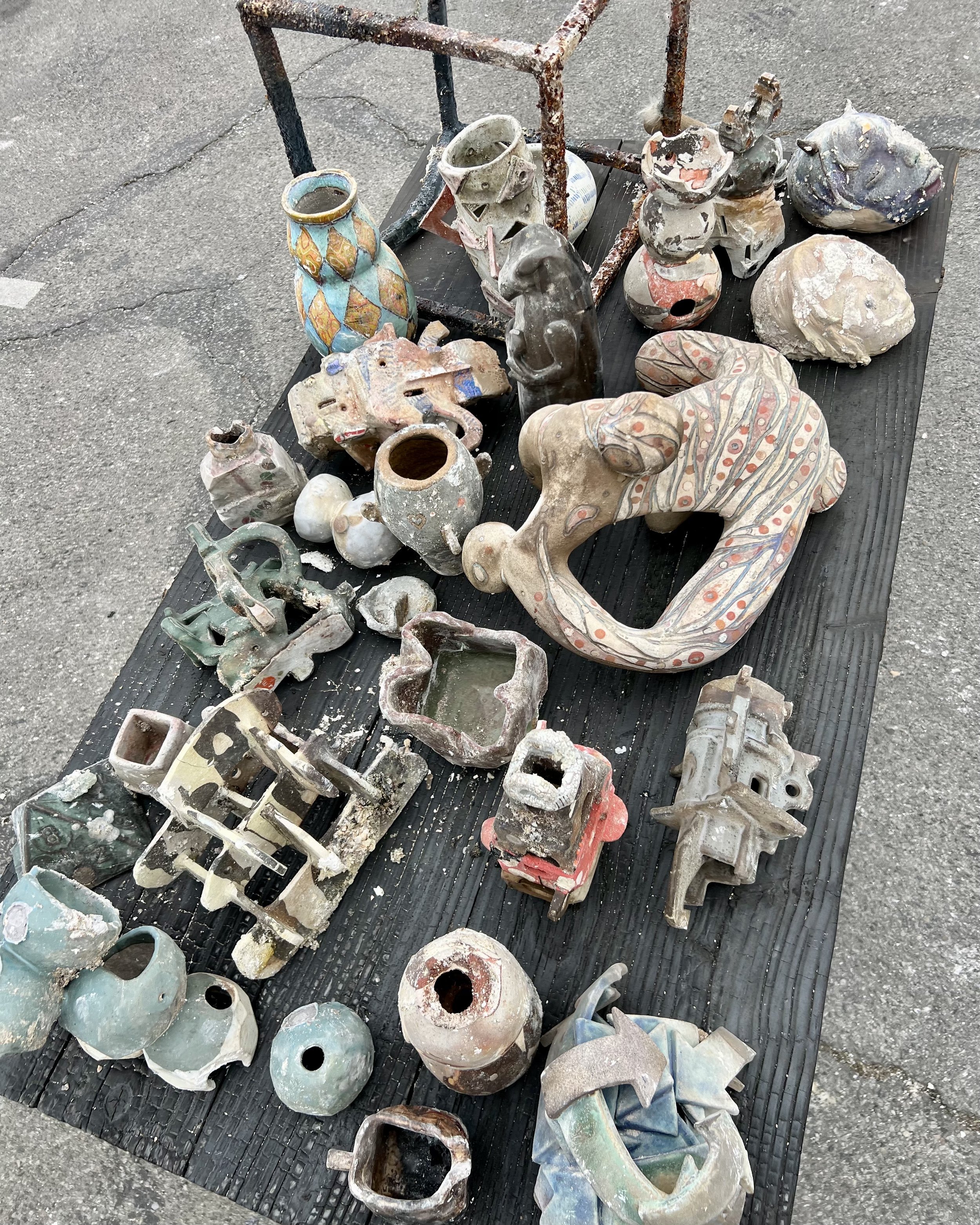From the Ashes: How The Los Angeles Wildfires Affected the Local Art Market
As wildfires raged through Los Angeles in January, leaving destruction in their wake, the city’s artist community came together—not just to mourn and grieve, but to rebuild and uplift one another. I spoke with several LA-based art market professionals about the impact of the fires, exploring themes of loss, risk management, insurance challenges, and Frieze LA.
The smoke and haze surrounds Altadena. Photo Courtesy: eberhard & alto_beta on Instagram.
On January 7th, 2025, wildfires engulfed much of the Los Angeles neighborhoods, the Pacific Palisades and Altadena. While wildfires are nothing new to California, the size and scope of this event was unprecedented. For over three weeks the fires burned, destroying more than 6,800 structures and burning 23,448 acres across the Palisades, and more than 9,400 structures across 14,021 acres in the Altadena area, according to the New York Times. News of their full containment finally came on February 1st, leaving at least 29 dead, 14 still missing and thousands displaced.
For the robust artist community of Altadena, the loss was unimaginable. Many artists lost homes or studios, and countless irreplaceable works of art and archives were destroyed. The Guardian reported that 190 artists had lost or suffered significant damage to their homes, studios, and work.[1]
Included, but not limited to that list; painter Alec Egon lost two years of work that had been scheduled to debut in February. The personal library of writer Gary Indiana, which arrived in LA from New York on the morning of January 7th, was completely destroyed. Gallerist Ron Rivlin reported that the fire consumed more than 200 works of high-value art in his Palisades home, including several Warhols. Hundreds of musical scores by modernist composer Arnold Schoenberg, stored at the Palisades home of his son, were also consumed by the fires.
Not just artists, but collectors as well were affected. Elizabeth East, a gallery director at LA Louver, told me, “We have quite a number of clients who lost their homes completely. And then we have others who are still in evacuation zones or adjacent areas. People are trying to piece together what was lost, trying to inventory their collections from memory. That’s a nearly impossible task for some.”
“I just know that a lot of artists’ lives have been impacted. They’ll have less time to work because they’ll be putting their lives back together, they’ll be putting their homes back together, they’ll be putting their studios back together. At many different levels. Many different strata of professional artists will be starting over.”
The fires came just weeks before Frieze LA, one of the most significant art events in the city, leading many to wonder if Frieze would (or should) continue on. Vanity Fair reported on January 10th that multiple galleries throughout the city, even those outside of the hot zones, were closed. Opening receptions scheduled for that weekend at galleries such as Gagosian, Karma, François Ghebaly, David Kordansky Gallery, and Regen Projects, had also been postponed.[2] The financial toll taken on the city’s art market will be far reaching, not only in loss of sales, but in destroyed works. ARTnews quoted Christopher Wise, vice-president of Risk Strategies Company as saying, “tons of art has been destroyed. In value terms we are talking many billions of dollars.”[3]
To better understand how these fires were affecting the local artist community, I spoke with Brad Eberhard, artist and owner of Alto Beta Gallery in Altadena, which was tragically burned down on January 8th in the Eaton fire.
Alto Beta was not a typical white-cube style gallery. It acted more as a social space for artists and patrons, known for its warm, communal atmosphere, and showcasing mid-career artists who hadn’t had solo shows in California in the past 3-5 years. “It was not an antiseptic space,” Eberhard said. “It had a slight domestic quality, there was a 60 gallon planet aquarium, comfortable chairs, vinyl, good stereo, a library of art books. Depending on the conversation people would often turn to me, I would grab a book from the shelf and show them someone I’m excited about. Or, play them records appropriate to our conversation, and I would like to continue that.”
Remains of Alto Beta Gallery. Photo Courtesy: alto_beta on Instagram.
In one day, Eberhard lost his gallery, his studio, and much of his own work from the past five years, including over 70 sculptures. The artist whose work was on display, Mary Anna Pomonis, lost ten paintings. “There’s an immediate effect of lack of inventory and potential loss of income,” he explained.
L.A. based artist Robert Szot also spoke to me about the implications of a loss like this for artists, “There’s the financial aspect—the loss of raw materials, a space to work—but really, it’s the loss of completed works that you spent countless hours on. You can never get those back.”
One of the biggest issues that has come out of this tragedy for so many people is that of insurance. Insurance companies pulling out of certain regions of California has been an ongoing issue for the past few years, one which is only compounded by this event. CNN found that between 2020 and 2022, insurance companies declined to renew 2.8 million homeowner policies, while some companies have chosen to pull out of California altogether.[4] No coverage and high premiums are already a problem for many Californians, but it is especially complicated for those with art collections. Amir Nikravan, a professor at ArtCenter College of Design who lost his family home along with most of his block, told the Guardian, “Most artists are collectors, but unlike real collectors, we can’t necessarily afford $2,000 a month to insure the work.”
Exterior Picnic Table of Alto Beta Gallery. Photo Courtesy: alto_beta on Instagram
Adam Prideaux, managing director of the art brokerage firm Hallett Independent explained to me, “The principle is, insurers need to make a profit. And they need to underwrite to make a profit…Insurers will decide not to provide fire cover and hope that the client just can go elsewhere and find it. But, if the client can't go elsewhere, then they’re really stuck.”
And many have, in fact, found themselves stuck. Eberhard, who had no insurance on his rented gallery space, explained, “I don’t know how to protect my work. Renters insurance wouldn’t have covered my art, and specialized insurance is prohibitively expensive.”
“The problem with a catastrophe risk is that, if it’s an earthquake or a fire, it’s everything, it’s not just an individual work.”
Szot, who runs a workshop out of his Atwater Village studio told me about one of his students, saying, “I know of at least one person that told me they paid anywhere from $15 to $20,000 a year to insure just the physical house itself, not the contents. And she said she recently got a quote saying that it's gone up from that $15-$20,000 to $115,000 a year.” This is not an isolated incident. And, after an event like this, insurance premiums that don’t disappear are sure to go up astronomically.
Even for art collectors who did have insurance, the journey of collecting on losses will be a complicated one. “Some people underinsured their works without realizing it,” East noted. “A collector told me, ‘I had insurance, but I lost X—how much do you think that’s worth?’ And it turned out the value of the work had doubled since they last updated their policy. There’s a lot of confusion and heartbreak ahead.”
Even those who had emergency plans in place found themselves unable to fight the elements. “One of my clients had an art handling firm on-site and was about to start removing pieces from their home,” Catie Rini Patton, a consultant at Heather James Fine Art, told me. “But then they decided it was too close to the fire and aborted. Luckily, the house was spared, but at a certain point, there’s only so much you can do. Mother Nature will take what she wants.”
But amongst all of the loss and tragedy, the LA art community is pushing forward, as evidenced by the commencement of LA art week. After much speculation, Frieze LA decided to continue on as planned and opened February 20th, with art fairs Felix, the Santa Monica Post Office, The Other Art Fair and The LA Art Show also going ahead as planned.
“I have a different view of the LA world after this experience. I find it to be a more caring and generous place and a more interconnected place than I knew before this fire.”
East explained the intricacies of deciding whether to participate in Frieze or not while the fires still burned: “I had a colleague who felt extremely strongly [about] Frieze going forward… If it's going ahead, is it going ahead for the right reasons? Why would I not want to have it done? People want to do the right thing. And I think that it's not only the right thing on a micro level; is this the right thing for my business? But what is the right thing for Los Angeles? What is the right thing for the artists? And that can be very tough to answer.”
Photo Courtesy: Frieze
“People carry on in the face of all this. They do things like continue to make paintings, which is a beautiful and very surprising thing. But it’s great and I’m glad to be a part of that in some small way out here in LA.”
But the community support for the fairs was very strong. Eberhard was invited to use a booth at the Santa Monica Post Office, the gallery’s first time participating in an art fair. Frieze reported multiple sold-out booths, and Artsy reported a palpable energy of festivity and camaraderie at the fairs. The artistic community of Los Angeles, while still devastated and rebuilding, came out in force to support its artists.
Besides just well sold fairs, the LA community has formed several relief funds for artists and others in the artistic community affected, including but not limited to the J. Paul Getty Trust, the Los Angeles County Museum of Art and the Hammer Museum coming together to establish a $12 million relief fund to support affected artists.
Photo Courtesy: Post-Fair
The success of these art fairs shows a willingness on the part of LA collectors to rebuild and continue investment in their collections. East reported to me the story of a client who lost some pieces in the fire, and called the artist not only to let them know of the loss of their work, but to see about getting new works from them.
But besides just rebuilding collections, what measures can be taken to protect against events like this in the future? One of the best things you can do, according to Prideaux, is have a good relationship with an art shipper, much like the one? Patton’s client had in place. This allows for the collector to be ready when evacuation orders come to have transport for their collection to a safe storage space. Patton told me about another measures she took to help a client, “We offered to essentially inventory their collection and made a book for them. There's a digital version [and] also a hard copy. We prioritized the order from front to back, the more important pieces had larger images and two page spreads, whereas the less significant, less expensive pieces were more thumbnails. But what that allowed is if they needed somebody to come into their home quickly, they'd have that book there they could just reference and know visually which works to prioritize over others, if they had a limited time to remove work.”
The unprecedented nature of this event has forced Los Angeles and the world to face some hard, undeniable truths about climate change. As time goes on, events like this will only become more frequent, and there is a limit to the extent one can mitigate those risks. But as LA has shown in the aftermath of the wildfires, tragedy doesn’t stop artistic expression. Szot spoke to me about this:
“Events like this don't stop people from continuing to create things. It becomes this, almost compulsion to make, that you can make in any circumstance…I was very fortunate to only have been affected in a small way by the fires, and certainly I'm on the ground now trying to support artists that I’ve met here in Los Angeles in the last couple of years, to try to get them back to whole again so they can start working again, and these efforts continue all around the city.”
Szot also told me about a piece he had been working on at the time the fires broke out, “[There] was a painting I had been working on for about six weeks and was struggling to figure out. I finished that painting that week [that the fires started], and I looked at it and thought, ‘there is something emotional about this painting that I didn't see before’. I began to realize that it was connected to my father, who died about three years ago. His first house was in the Palisades, and he used to talk about having bought that house as a young man. [I’m] thinking about him in that house, and I'm thinking about the current conditions of the Palisades, how that neighborhood has just been kind of wiped off the face of the earth. I looked at this painting differently. And when I look at it now it's always going to be that stark reminder of that week. The painting is actually called Palisades.”
But the people of LA are resilient, and carry on. Through the kindness of other galleries, Eberhard has been able to put on all of his scheduled shows for 2025, and while excavating the rubble of his former studio and gallery, found several of his own sculptures and ceramics that survived. Alto Beta has recently found a new space and will move in in April. The gallery will live on in Altadena, something Eberhard never thought was a possibility.
Ceramic Sculptures by Brad Eberhard, excavated from the ruins of Alto Beta Gallery. Photo Courtesy: eberhard on instagram
In times of intense crisis and physical distress, especially where human life is at risk, luxuries like art take a back seat to other priorities. Yet in times of pain and loss, art is still what connects people to life, and to each other, the most.
Robert Szot, Palisades, 2025, oil, metal leaf on linen, 80x74 in.
A special thank you on behalf of MADE IN BED to:
Footnotes
[1] Moffitt, E. Landmarks destroyed, masterpieces incinerated, communities razed: how the LA fires ravaged culture. (2025).
[2] Freeman, N. How the Los Angeles Fires Have Affected the Art World. (2025).
[3] Artprice.com. Artmarket.com: Wildfires in Greater Los Angeles, Artprice deplores an inestimable loss for the world’s artistic heritage. (2025).
[4] Isidore, C. California’s insurance is in crisis. The solution will cost homeowners a ton. (2025).
Bibliography
[1] Alto Beta. (2025). Alto Beta Gallery | Home | Past Exhibitions. [online] Available at: https://www.altobeta.com/past [Accessed 3 Mar. 2025].
[2] Armstrong, A. (2025). L.A.'s Galleries and Fairs Push for a Return to Business—and More Art Industry News | Artnet News. [online] Artnet News.
[3] Artprice.com. (2025). Artmarket.com: Wildfires in Greater Los Angeles, Artprice deplores an inestimable loss for the world’s artistic heritage - Artmarketinsight - Artprice.com.
[4] Cassady, D. (2025). Relief at Frieze LA as Dealers Report Sold-Out Booths and Big Sales. [online] ARTnews.com.
[5] Chotiner, I. (2025). How Did the Los Angeles Fires Get So Out of Control? [online] The New Yorker.
[6] Christ, E. (2024). The Suburbs Are Dead? - Artillery Magazine. [online] Artillery Magazine.
[7] Dalbow, T.A. (2025). After Tragedy, L.A. Art Week 2025 Showcased Resilience, Creativity, and Community. [online] Artsy.
[8] Evans, J. (2025). LA fires: Climate change’s fingerprints all over deadly wildfires. [online] Daily Maverick.
[9] Freeman, N. (2025). How the Los Angeles Fires Have Affected the Art World. [online] Vanity Fair.
[10] Frieze.com. (2025). FAQs | Frieze Los Angeles 2025 | Frieze. [online]
[11] Gelt, J. (2025). How the Getty Villa saved itself from the Palisades fire. [online] Los Angeles Times.
[12] Guzman-Lopez, A. (2025). 17 employees helped save the Getty Villa from the fires. They’re telling other museums how it was done. [online] LAist.
[13] L.A. Artists Mourn What Was Lost in the Deadly Fires. [online] Artnet News.
[14] Isidore, C. (2025). California’s insurance is in crisis. The solution will cost homeowners a ton. [online] CNN.
[15] Jacobs, H. (2025). GALA Calls for a Return to Business Amid Greater LA Fire Recovery. [online] ARTnews.com.
[16] Jiménez, J. (2025). Palisades and Eaton Fires in Los Angeles County Are Fully Contained. The New York Times. [online] 1 Feb.
[17] Moffitt, E. (2025). Landmarks destroyed, masterpieces incinerated, communities razed: how the LA fires ravaged culture. [online] the Guardian.
[18] News Desk (2024). Frieze Los Angeles Unveils Plans for 2024 Iteration. [online] Artforum.
[19] Rey, M.D. (2025). Los Angeles Getty Center’s priceless collection braces for wildfires as evacuation order expands to museum. [online] The Independent.
[20] Scheer, N. (2025). The Art World’s Response To The California Wildfires. [online] Rehs Galleries.
[21] Stromberg, M. (2025). The Unfathomable Loss of Artistic Heritage in Altadena. [online] Hyperallergic.
[22] Sutton, B. (2025a). Deadly wildfires destroy Los Angeles art spaces as museums and galleries close. [online] The Art Newspaper - International art news and events.
[23] Sutton, B. (2025b). Frieze will proceed with Los Angeles fair following deadly wildfires in the city. [online] The Art Newspaper - International art news and events.
[24] Zheng, E.Y. (2025). Boutique Fair Post-Fair to Launch in L.A. [online] Ocula.com.
Basha Shapiro
Art Markets Co-Editor, MADE IN BED








